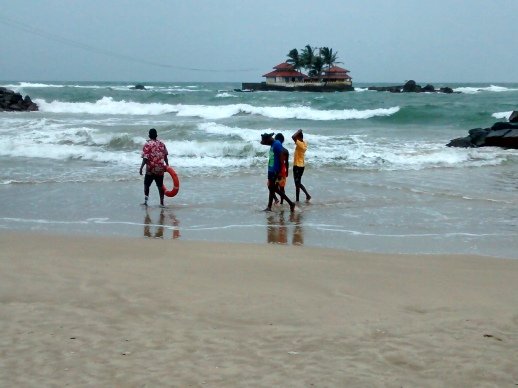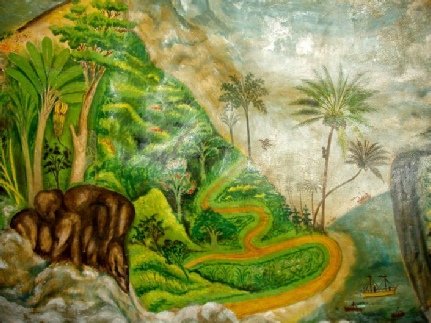© 2023 Dr Margaret Sheppard
Devol-deviyo Legends
There are various versions of the origin legend associated with Devol-
Three merchants had set sail from Southern India with the intention of trading in Sri Lanka but were caught in a terrible tempest so they tried to land at the first safe place which was near Deondra in the far South. However the Deity Pattini who controlled the area, refused them permission to disembark.
So they continued further along the coast and managed to reach land but quickly saw that the area was unsuitable for settlement. They then continued to sail West but were shipwrecked in another tempest and only three of them managed to swim ashore, the rest of the sailors were drowned and all the trade goods were lost in the tempestuous seas .
Where they had reached the shore was at Seenigama just North of modern day Hikkaduva. However Pattini controlled this area as well. She ordered a high fence of seven layers of fire to be erected to prevent them from going inland from the beach. But these men were skilled in mantra (spells) and knew the magic to overcome these fiery barriers. They trampled the fence down and quenched the fire and they resolved to settle there permanently. Their names were: Gini-
These three men were experienced in the use of many magic spells, for instance they knew how to transform potsherds into money. This enabled them to buy food and so they were able to survive. Then, two of them moved South to settle in Panguru and Deondra, while the third, Devol-
Here he continued to support himself by changing sand into sugar; but one day one of his children saw him doing this and told his mother. Devol was so angry he killed the child. However the people heard about his gifts and skill in the use of mantra and sorcery and started to revere him and treat him as a Deity. They renamed him Devol-
When he died a shrine was built on the spot where he had lived and supplicants regularly brought offerings to this shrine.
At Veragoda there is a very ancient tree believed to have been planted by Devol-
Of his other two former companions who had survived the tempest and had settled further South, Gini-
Another version of the Devol-
He first travelled inland to Saman-
At Unawatuna, near Galle, the Deity Ganapathi sent him away; as did Vatameta-
Finally he arrived at Seenigama, near Hikkaduva, the home of Pattini. She had already seen the strange vessel from afar and welcomed him. Many other Deities had assembled there, thirty-
So, he at once began to perform transforming sand into rice. Pattini was very pleased with this skill but then gave him a further task telling him that if he performed it she would allow him to settle. She ordered seven enormous fences of fire to be erected, each one sixteen miles high and 16 miles long. She told him to tear these down , eat the fire and trample them underfoot. He accepted the challenge and stated that this would be an easy task.
He then “ate” the fire, trampled it under his feet so that the flames were extinguished, and danced about on the remains until there was nothing more to be seen of it and the spot was absolutely cool. When he had finished, he stood before Pattini, and all the other Deities surrounded him,complimenting him on his great skills. Then, Dohala stepped forward and announced that so skilful a man should be honoured and invited him to join them as a Deity. He would then have a place in their ceremonies, (the gam-
The whole assembly agreed with this proposal. They gave him the name Devol-
Andun-
Devol-deviyo
Devol-
Like the majority of the Deities he originates from Southern India. Some legends associated with him are enacted and sung by the Tovil dancers during Pattini and exorcism ceremonies (see sections on Pattini and Tovil Ceremonies).

(Image from Sri Lanka’s “Sunday Observer”)

Yet another version of the legend is that Devol Deviyo was one of the seven sons of King Ramasinghe of India . The king had to send the seven brothers away to safety as the Yaksha tribe was troubling the kingdom. Each brother was provided with a ship. Devol Deviyo was known to be a skilful and talented naval officer and was thus known as Neelamani. His ship was made of pure gold. The brothers engaged in trade for some time but as the seven ships entered Sri Lankan waters, they were caught in a tremendous storm and all the ships were destroyed and the trade goods lost to the deep. Devol Deviyo prayed for strength to reach land. Sakra saw this through his sixth sense. He created a large rock in the sea for Devol Deviyo to cling onto, and entrusted the Deity of the Great Seas, Manimekala, to ensure he reached land safely. The survivors travelled all around the island but were unable to disembark at any point as there were resident guardian Deities for these regions already.
Devol Deviyo finally arrived at Seenigama, where at first the resident Deities refused him permission to land. However, he convinced them by explaining that Pattini, who was the Deity of Seenigama at that time, was his sister from a previous birth. He had to prove himself by passing the many tests that they set for him -
From that day forth, Pattini stipulated that Neelamani would be known as Devol Deviyo and would be the Deity of Seenigama and that she would make Nawagamuwa her realm instead.
The islet is supposed to be the rock that provided safe passage to Devol Deviyo and is said to have moved over time to its present location.

Devol-
Pilgrims flock to both the land and island temples to make offerings to Devol-
These legends about Devol-


Images from Temple paintings showing the arrival of Devol-